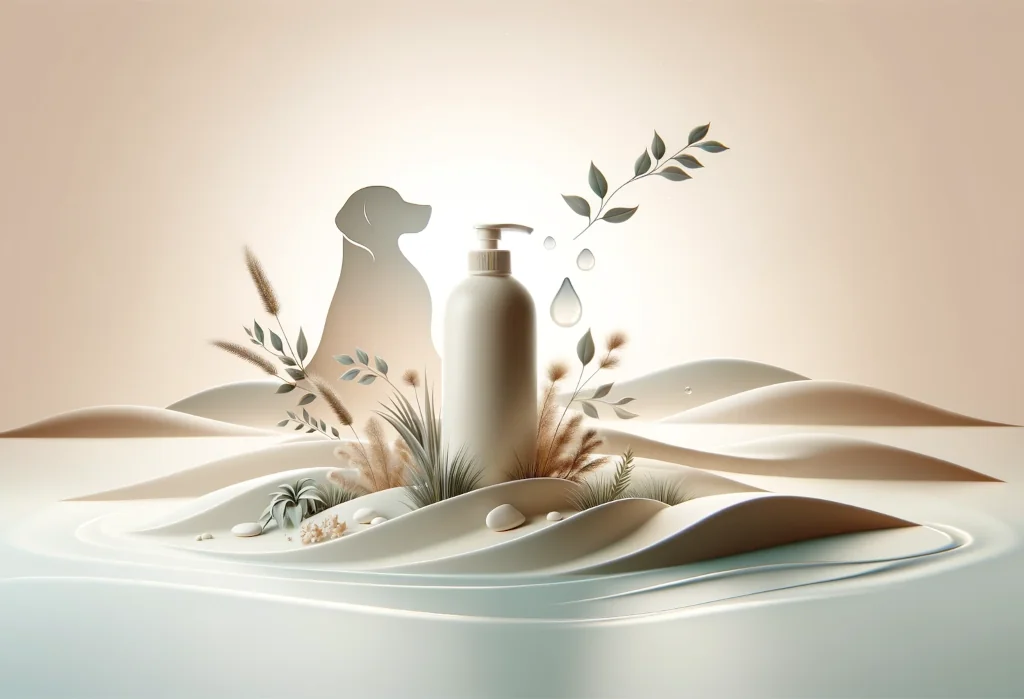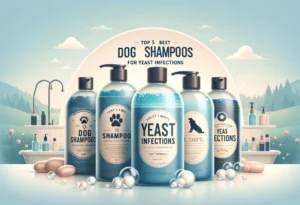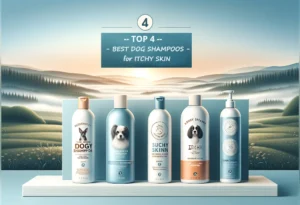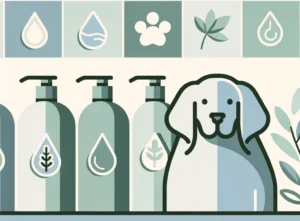Watching your furry friend scratch endlessly is like listening to a never-ending bad song on the radio — unbearable for both of you. It’s time to change the station and find some relief.
This post will guide you through the maze of choosing the best dog shampoo for yeast infections, ensuring your pooch can get back to its playful, itch-free self.
Key takeaways:
- Choose a dog shampoo with antifungal properties, such as those containing miconazole or chlorhexidine, for effective yeast infection treatment.
- Incorporate soothing ingredients like oatmeal and aloe vera in your dog’s shampoo to help relieve irritated skin, and ensure it’s pH balanced for dog skin.
- Manage your dog’s yeast infection with a balance of frequent baths using the right shampoo, a proper diet including high-quality proteins and probiotics, and always consult your vet for tailored advice.
Why Does Your Dog Keep Scratching? Understanding Yeast Infections
If your furry friend can’t seem to stop itching and scratching, it may be more than just a passing nuisance. Yeast infections in dogs are a common culprit behind this relentless discomfort. The gist of it is, a yeast infection is an overgrowth of the yeast naturally found on your dog’s skin. This imbalance can lead to itchiness, redness, and a foul odor.
So, what’s the deal with these infections? Well, they often stem from a variety of factors, including allergies, hormonal imbalances, or excessive moisture trapped in their fur or between their paws. It’s essential to pinpoint the root cause because, just like a bad penny, yeast infections have a knack for coming back if not properly managed.
Understanding the nature of yeast infections is the first step in helping your furry pal find relief. It sets the stage for why choosing the right dog shampoo is not just a luxury, but a necessity.
What Should You Look for in a Dog Shampoo for Yeast Infections?
When on the hunt for the perfect shampoo to combat your dog’s yeast infection, keep these key factors in mind:
-
Antifungal properties : This is the bread and butter of any yeast-fighting shampoo. Ingredients like miconazole or chlorhexidine can effectively tackle yeast at its roots. A product like Malaseb shampoo is a prime example, packing a punch against both fungi and bacteria.
-
Soothing ingredients : Your dog’s skin is already irritated and possibly damaged. Ingredients like oatmeal, aloe vera, and vitamin E can soothe and promote healing.
-
Avoid irritants : Just as important as what is in the shampoo is what’s not. Steer clear of fragrances and dyes, which can exacerbate skin irritation. Parabens and sulfates, commonly found in many cosmetic products, are also a no-go.
-
pH balanced : Dogs’ skin has a different pH level compared to humans, so a shampoo that respects this balance is crucial. Using a product not designed for pets can disrupt their skin’s natural defenses.
Unique insight:
Here’s something you might not find on every blog: Consider the texture and lather of the shampoo. A shampoo that rinses easily can reduce the time your dog spends in the bath, minimizing stress for pets sensitive to water or those with particularly thick coats. This small detail can make a significant difference in the overall bathing experience for both you and your dog.
Can Diet Affect Your Dog’s Skin Health?
Absolutely! Often overlooked, diet plays a pivotal role in managing yeast infections. Just as with humans, what your dog eats can influence their skin health profoundly. Here’s how you can tweak their diet to support their skin:
-
Quality proteins : Opt for high-quality, easily digestible proteins. Fish or lean meats like chicken can be excellent choices, providing the building blocks for healthy skin.
-
Balanced Omega fatty acids : Omega-3 and Omega-6 fatty acids are key to reducing inflammation and promoting a healthy coat. Fish oil supplements or flaxseed can be great additions to their diet.
-
Probiotics : These beneficial bacteria are not just good for the gut. They can help balance the skin’s microbiome, too. Incorporating fermented foods like kefir or probiotic supplements can make a noticeable difference.
-
Hydration : Never underestimate the power of water. Ensuring your dog has constant access to fresh, clean water supports skin hydration and overall health.
Practical advice : While diet changes can offer substantial benefits, they’re not an overnight fix. Like any good thing, it takes time to see the results. And, this doesn’t replace the need for a targeted topical treatment like a quality medicated shampoo but complements it.
Remember, every dog is unique. What works wonders for one may not have the same effect on another. It’s always a good idea to consult with your vet before making significant changes to your dog’s diet or skincare routine, especially if they’re dealing with a stubborn yeast infection.
Natural vs. Medicated Shampoos: Which Is Better?
Deciding between natural and medicated shampoos for your furry friend’s yeast infection can be a bit like navigating a maze – both come with their own set of instructions and potential outcomes. Here’s a little guidance to help you choose which path might be best for your pup.
Natural Shampoos are often lauded for their gentle approach. They’re usually packed with ingredients you can pronounce, such as oatmeal, aloe vera, and tea tree oil. These components can soothe your dog’s irritated skin and offer a calming effect without the harsh chemicals. However, it’s crucial to remember that while natural shampoos can provide relief and help maintain a healthy skin pH, they may not always be powerful enough to combat a severe yeast infection on their own.
Pros:
– Gentle on the skin
– Typically free of harsh chemicals
– Can soothe irritation and maintain healthy skin pH
Cons:
– Might not be effective for severe yeast infections
– Requires consistent, long-term use for noticeable results
On the flip side, Medicated Shampoos are your go-to warriors in the battle against stubborn yeast infections. Formulated with antifungal agents specifically designed to target yeast, these shampoos can quickly reduce symptoms and offer relief. It’s important, though, to use them as directed and to keep an eye out for any potential side effects, as some dogs might find the strong ingredients a bit too harsh.
Pros:
– Potent against yeast infections
– Offers quick relief for symptoms
– Formulated for specific skin issues
Cons:
– May cause irritation in some dogs
– Strong ingredients can be harsh on sensitive skin
Remember, the best choice depends on your dog’s specific situation and needs. In some cases, a combination approach using both natural and medicated products may provide the perfect balance. Always consult with your vet before starting any new treatment plan.
How Often Should You Bathe Your Dog If It Has a Yeast Infection?
Finding the right balance for bathing your dog with a yeast infection is akin to striking gold. Bathe too often, and you risk drying out their skin, leading to more irritation. Bathe too infrequently, and the yeast has a field day, flourishing in the warm, moist environment of your dog’s fur. So, what’s the golden rule?
For Mild to Moderate Infections:
- Initial Phase: When you first start treating the yeast infection, a bath with medicated shampoo every 3-5 days can significantly help reduce yeast levels and soothe irritation.
- Maintenance Phase: Once you see improvement, reducing the frequency to once a week can help maintain the skin’s health without over-drying.
For Severe Infections:
- Your vet might recommend a more aggressive treatment plan initially, possibly involving bathing every other day. However, this should only be done under veterinary guidance to avoid skin damage.
Key Tips for Bathing:
- Water Temperature: Use lukewarm water. Too hot or too cold can worsen skin irritation.
- Shampoo Contact Time: Ensure the shampoo stays on the skin for at least 5-10 minutes before rinsing. This contact time is crucial for the medicated ingredients to work effectively.
- Pat Dry: Instead of rubbing, gently pat your dog dry with a towel to prevent irritation of the sensitive skin.
Here’s a unique tip you might not find everywhere: Tailor the Bathing Schedule to Your Dog’s Skin Reaction. Monitor your dog’s skin closely after each bath. If you notice any dryness or increased irritation, extend the time between baths. Conversely, if the skin seems to handle the bathing well without adverse reactions, you might adjust the frequency slightly up, especially during severe flare-ups, always consulting your vet for guidance.
By acknowledging your dog’s individual response and adjusting the treatment plan accordingly, you provide a custom-fit solution that could greatly enhance their comfort and recovery speed.
In conclusion, whether you opt for natural or medicated shampoo solutions, the key is to remain observant and responsive to how your dog’s skin reacts to treatment. The battle against yeast infections is often won by those who are attentive and adaptable to their dog’s needs. Remember, consulting with your veterinarian can provide invaluable insights and recommendations tailored to your pup’s unique situation.
Alex, a passionate animal lover, has experience in training and understanding animal behavior. As a proud pet parent to two dogs and three cats, he founded AnimalReport.net to share insights from animal experts and expand his knowledge of the animal kingdom.









